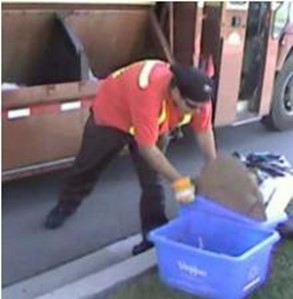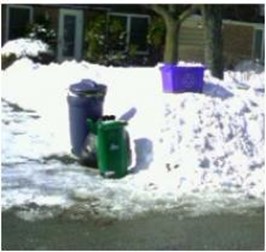Collection of Recyclables
Concern Details
Background:
One worker is responsible for retrieving organic and recycling bins from the curb (vertical height of green bin: 66 cm, vertical height of blue bin: 30 cm) and lifting them into the side hopper of the truck (minimum vertical height: 104 cm). The worker normally lifts one bin at a time, however, on occasion they will stack the bins on top of each other and carry them to the hopper. The average green bin weight is 10.8 kg, and the average blue bin weight is 5.4 kg. The worker does approximately five lifts per minute.

Evaluation
This job is cause for concern for many reasons. These concerns are discussed in further detail below. Overall, the concerns on this job expose workers to an increased risk of injury due to back exposure.
- High back loads that increase risk of injury.
- The biomechanical human model revealed concern with spinal loading and strength limitations for workers to perform the job. Lifting the blue bins that are over 12 kg results in high back loads which increases the risk of injury.
- The bins are outside the accepted lifting zones.
- Retrieving the blue bins from a vertical height of 30 cm requires significant back flexion and places the workforce at an increased risk of injury. This job results in poor lifting conditions which are a cause for concern as the location of the bins are typically below knee height
- Repetitive, awkward postures which increase risk of injury.
- Due to the height of the hopper plus the size of the bin, workers must raise the bin to a vertical height above 120 cm. The vertical height to dump the recycling and organic material into the hopper causes repetitive awkward shoulder postures4, increasing the risk of injury. The low vertical height of the bins results in repetitive awkward back postures which are cause for concern.
- Awkward postures are a much greater risk during winter conditions, when customers put bins on snowbank.

Summary:
Due to these concerns and risk factors, countermeasures are recommended to reduce the risk of developing musculoskeletal disorders when collecting recyclables. The following section provides countermeasure recommendations to mitigate the risk of injury.
Controls
Due to the high risk of injury from repetitive, heavy lifting, it is recommended to eliminate the manual lifting of the waste. The optimal solution would be to investigate automated load trucks, with a lifting mechanism to automatically empty large carts called “toters” without the operator having to lift the recycling by hand. The challenge to this countermeasure is that it involves the community to change to a standard toter.
If the above solution is not feasible, it is recommended that the blue bins be re-designed to the same specifications of the green bin (vertical height: 60 cm), which would reduce the back flexion required to retrieve the bin. It is also recommended to investigate a recycling truck with a lower side hopper height which would reduce the awkward shoulder postures to dump the recycling bins. Implementing these countermeasures would reduce the risk of injury to the workforce.
Decreasing the lifting frequency can be achieved by reducing the number of stops for each individual worker. It is also recommended to consider payment by the hour instead of by tonnage or using a “finish and go home” pay scheme that encourages work at excessively fast rates which increases the potential for injuries.
Awkward postures can be improved by communicating with the community on where garbage should be placed, especially in winter months. In addition, trucks with lower hoppers should be purchased.
References or resources
The information contained in this document was developed in partnership with the Infrastructure Health and Safety Association (https://www.ihsa.ca/topics_hazards/msds.aspx) and CRE-MSD as part of the following project funded by the Workplace Safety and Insurance Board (Ontario):
Kramer, D., Bigelow, P., Vi, P., Garritano, E., Wells, R. Encouraging construction companies to adopt innovations to reduce MSDs using different knowledge transfer techniques. 2008-2011.
